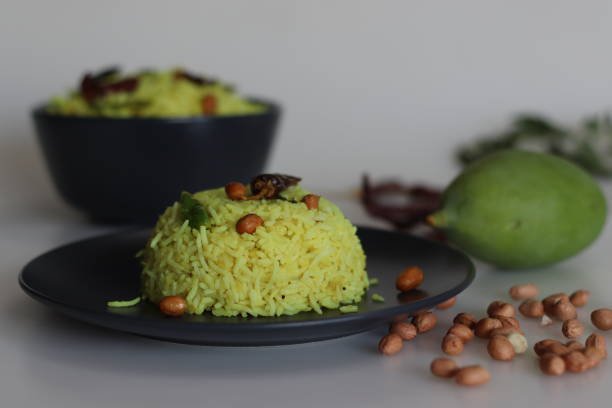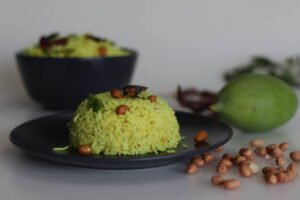Mango rice, known as Mavinakayi Chitranna in Kannada, Mamidikaya Pulihora in Telugu, and Mangai Sadam in Tamil, is a beloved South Indian dish that celebrates the raw, unripe mango. This vibrant rice dish is a perfect blend of tanginess, spice, and crunch, making it a favorite during the summer months when mangoes are in season.
What Is Mango Rice?
Mango rice is a traditional South Indian mixed rice dish where cooked rice is sautéed with grated raw mangoes, tempered with mustard seeds, curry leaves, lentils, and garnished with peanuts and fresh coconut. The raw mango imparts a delightful tanginess, while the tempering adds depth and flavor, making it a comforting and satisfying meal.
Table of Contents

South Indian Raw Mango Rice
Ingredients
Method
- Cook the rice and let it cool completely. Spread it on a wide plate to avoid clumping.
- Heat oil in a pan. Add mustard seeds and let them splutter.
- Add urad dal and chana dal. Sauté until golden.
- Add peanuts and cashews. Fry until roasted.
- Add red chilies, green chilies, and curry leaves. Sauté briefly.
- Add turmeric and asafoetida. Stir well.
- Add grated raw mango and sauté for 2–3 minutes until slightly soft.
- Add salt and mix.
- Add the cooled rice. Gently combine with the mango mixture.
- Garnish with grated coconut and chopped coriander leaves. Serve warm or at room temperature.
Notes

Ingredients
Rice: 1 cup (preferably Sona Masoori or Ponni rice)
Raw Mango: 1 medium-sized, peeled and grated
Green Chilies: 2-3, slit
Dried Red Chilies: 2, halved
Mustard Seeds: 1 tsp
Urad Dal (Black Gram Lentils): 1 tsp
Chana Dal (Bengal Gram Lentils): 1 tsp
Peanuts: 2 tbsp
Cashew Nuts: 1 tbsp (optional)
Curry Leaves: 1 sprig
Turmeric Powder: 1/4 tsp
Asafoetida (Hing): 1/4 tsp
Salt: to taste
Oil: 1 tbsp (preferably sesame oil for authentic flavor)
Fresh Grated Coconut: 2 tbsp (optional)
Fresh Coriander Leaves: for garnish
Instructions
Step 1: Cook the Rice
- Wash the rice thoroughly under running water until the water runs clear.
- Cook the rice in a pressure cooker or a pot with 2 cups of water. If using a pressure cooker, cook for 2 whistles. Allow the rice to cool completely. Spread it on a wide plate to prevent clumping.
Step 2: Prepare the Tempering
- Heat oil in a pan over medium heat.
- Add mustard seeds and let them splutter.
- Add urad dal and chana dal. Sauté until they turn golden brown.
- Add peanuts and cashew nuts (if using). Fry until the peanuts are roasted.
- Add dried red chilies, green chilies, and curry leaves. Sauté for a minute.
- Add turmeric powder and asafoetida. Mix well.
Step 3: Cook the Raw Mango
- Add the grated raw mango to the tempering.
- Sauté for 2-3 minutes until the mango softens slightly but retains its crunch.
- Add salt to taste and mix well.
Step 4: Combine with Rice
- Add the cooled rice to the mango mixture.
- Gently mix to combine, ensuring the rice is well coated with the mango and spices.
- Garnish with fresh grated coconut and coriander leaves.
Step 5: Serve
Serve the mango rice warm or at room temperature. It pairs wonderfully with papad, pickle, or a simple yogurt side.
Tips for the Best Mango Rice
Choose the Right Mango: Select a firm, sour, unripe mango for the best flavor. Avoid using ripe mangoes as they are sweet and may not provide the desired tanginess.
Cool the Rice: Ensure the cooked rice is completely cooled before mixing. This prevents the rice from becoming mushy.
Adjust Spice Levels: Modify the number of green and dried red chilies according to your spice preference.
Add Crunch: Incorporate peanuts and cashew nuts for added texture and flavor.
Variations of Mango Rice
With Coconut: Add freshly grated coconut to the tempering for a richer taste.
With Lemon: If raw mangoes are not available, substitute with lemon juice for tanginess.
With Herbs: Incorporate mint or basil leaves for a refreshing twist.
Health Benefits
Mango rice is not only delicious but also nutritious. Raw mangoes are rich in vitamin C, antioxidants, and dietary fiber. The addition of lentils and nuts provides protein and healthy fats, making this dish a wholesome meal option.
FAQs
Can I use leftover rice for mango rice?
Yes, leftover rice works perfectly for mango rice. Ensure the rice is not clumpy and is at room temperature before using.
Is mango rice vegan?
Yes, mango rice is naturally vegan. However, if you add ghee or dairy-based yogurt as a side, it will no longer be vegan.
Can I make mango rice ahead of time?
Mango rice is best enjoyed fresh. However, you can prepare the tempering and grated mango mixture in advance and combine with freshly cooked rice when ready to serve.
How can I make mango rice spicier?
Increase the number of green chilies and dried red chilies in the tempering. You can also add a pinch of red chili powder for extra heat.
Can I use basmati rice instead of Sona Masoori?
Yes, you can use basmati rice. Just ensure it’s cooked to a grainy texture and not overcooked.
What can I serve with mango rice?
Mango rice pairs well with papad, pickle, raita, or a simple vegetable curry.
Can I make mango rice without peanuts?
Yes, you can omit peanuts if you have allergies or prefer not to use them. You can substitute with other nuts like cashews or almonds.
Conclusion
Mango rice is a delightful and flavorful dish that captures the essence of South Indian cuisine. Its tangy, spicy, and crunchy elements make it a favorite during the mango season. Whether served as a main course or a side dish, mango rice is sure to tantalize your taste buds and bring a taste of South India to your home.
Enjoy preparing and savoring this traditional dish that brings together the best of seasonal ingredients and time-honored culinary techniques.
Nutritional Chart
| Nutrient | Amount (per serving) |
| Calories | 320 kcal |
| Carbohydrates | 40–45 g |
| Protein | 6–7 g |
| Fat | 13–15 g |
| — Saturated Fat | 2 g |
| Fiber | 3–4 g |
| Sugar | 3–4 g (from mango) |
| Sodium | 300–400 mg (varies by salt) |
| Cholesterol | 0 mg (if no ghee used) |
| Vitamin C | ~20% DV (from raw mango) |
| Iron | ~8% DV |
| Calcium | ~4% DV |
| Potassium | ~200 mg |

